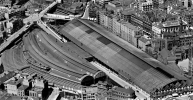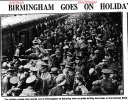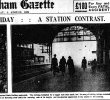Richard Dye
master brummie
Pretty complex stuff!Another shot of that office block behind Station St. Both my pictures are from "Britain from Above". I've corrected my mistaken naming of Navigation Street, #219.
View attachment 136698
Pretty complex stuff!Another shot of that office block behind Station St. Both my pictures are from "Britain from Above". I've corrected my mistaken naming of Navigation Street, #219.
View attachment 136698
I think it was LNER and yes they were all gradually merged loosing much of their identityI lived on the Lyndhurst Estate 1959-1972 and always thought the line bordering it's western boundary was LMS, I recently discovered from a map of 1892-1908 vintage it was actually L&NWR, were they amalgamated?
Peg.
I think it was LNER and yes they were all gradually merged loosing much of their identity.
Thank you...………...I stand corrected!It was the LMS. The London, Midland and Scottish Railway (LMS) was a British railway company formed on 1 January 1923 under the Railways Act of 1921, which required the grouping of over 120 separate railways into four. The companies merged into the LMS included the London and North Western Railway, Midland Railway, the Lancashire and Yorkshire Railway (which had previously merged with the London and North Western Railway on 1 January 1922), several Scottish railway companies (including the Caledonian Railway), and numerous other, smaller ventures.

Yes, in the forties and early fifties both LMR and WR used horse and cart until replaced by the three wheel Scammells.Was not the luggage collected and delivered by railway vehicles then?
Viv, wonderful photo!A nicely tinted aerial view postcard. Sorry no date. Viv.
View attachment 158085




Don't forget that before WW2, 'queueing' was unheard of....it looks pretty chaotic to me.
Viv
mine too i spent a lot of time on new st station spotting in the 50s60s.more so than snowhill.it was easier to get to,on a train from aston station i think the last time i was there was 1972.My last memory is a bit earlier, about 66/67. I was going for an interview for my next stage in education. A girl from school, friend but not a girlfriend, who lived near me, decided to come with me to see me off and wish me luck. Nice thought, but neither of us knew how to handle the situation, with all those entwined couples saying goodbye on the concourse, and I was coming back the same day, then normal school routine. A quick hug sorted it, but it still sticks in the mind. When I came back in the evening, that was the last time I used New Street.
My regular memories are 'trainspotting' there and Snow Hill from earlier times.
Andrew.
Never thought about that. I had an easy ride on the 29 bus to Snow Hill, New Street was across town. But still a GWR person at heart. I think Brunel and his father were brilliant!mine too i spent a lot of time on new st station spotting in the 50s60s.more so than snowhill.it was easier to get to,on a train from aston station i think the last time i was there was 1972.
Goodness me...that takes me back to the 1950's...that loco used to be on the Selly Oak ..Bournville.KN line so much, really takes me back to those spotting days for sure...so good to see a colour shot of it...many thanksHere is a train entering platform 10 in June 1962, showing some of the station buildings .
View attachment 169818
